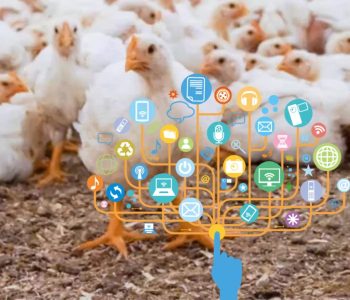Internet of Animals: the future for health and welfare assessments in poultry
This article reviews some of the sensors that are already being used to assess poultry welfare using the Internet of Animals, IoA. As well as looking into those sensors that are still being revised and that could soon become important monitoring tools.
The poultry industry has been receiving some of the benefits of the rapid expansion of electronic sensors, devices, telecommunications, software, the internet, and cloud-based connectivity. However, new developments in these areas can take us to a whole new level.
- The adoption rate of new technologies in the poultry industry is one of the highest in the agricultural sector. One of the most disruptive technologies is the Internet of Things (IoT), the network of interconnected devices and software without human
- In the poultry sector, the Internet of Animals (IoA) starts when these interconnected systems transfer data to the network related to the animal environmental conditions and the animal responses to be used in decision-making or to take immediate actions.
- The IoA belongs to the technological movement of smart farming and precision livestock farming technologies.
- The IoA can help to improve the efficiency, biosecurity, food safety, welfare, sustainability, and transparency of the poultry industry.
In the Internet of Animals, IoA, electronic sensors that measure physiological parameters may make a difference in future welfare assessments.
- Sound measurement can detect stress, infectious and parasitic diseases, or changes in feed consumption.
- Imaging technologies such as optical flow can detect walking problems, feather pecking, and early signs of infectious disease.
- Infrared technologies can assess a bird’s thermoregulatory characteristics and changes in metabolism due to diet, environmental or social stress.
We will review some of the sensors currently under evaluation and some already being used to assess poultry welfare.
Acoustic sensors
Bioacoustic sensors are helping to collect the large variety of sounds emitted by birds.
- Birds rely on acoustic communication for their social interactions and alarm signaling.
- The frequency of specific emitted vocalizations can be correlated with stress indicators. Software like Raven from the Cornell Lab of Ornithology made possible the analysis of these sounds.
- The behavior of birds is key to detect their welfare status.
- We are lucky that birds vocalize most of their behaviors; now, we need to understand them.
Technologies based on sound analysis are used in commercial hatcheries worldwide to minimize the hatching window or synchronize the hatch
- This technique was developed based on detecting the sound emitted by embryos when they reach or pass the internal pipping stage.
- Once the peak frequency of the sounds is detected, the incubator machine can adjust the temperature profile and the CO2 concentrations by closing and opening the dampers to narrow the hatching window stimulating other chickens with the same stage of embryonic development to hatching.
In farms, vocalization frequency can detect episodes where broilers or hens can not have access to feed.
- Higher rates of squawks and total vocalizations can signal the start point of feather pecking issues.
- The sound signals related to feather pecking have been characterized by a sudden increase in amplitude followed by a sudden decrease of signals between 1000 Hz to 5000 kHz.
Sound analyses can also help detect the adequacy of the thermal environment for broilers and laying hens.
- The models developed with the amplitude of vocalizations, the noise frequency spectrum, the energy, and the bandwidth of the signals have 98% accuracy in detecting stress episodes for birds.
- Broilers have a peak frequency of 600 randomly selected vocalizations, and the peak frequency of vocalizations decreased when broilers grew larger. Broiler breeder hens have specific vocalizations when deprived of nesting.
Sound signals have also been evaluated to detect and diagnose diseases.
- An Iranian group of researchers lead by Sadeghi detected necrotic enteritis derived from the infection of Clostridium perfringens from sound signals analyzed with artificial neural networks.
- The diagnostic accuracy was 66% six days post-infection and 100% eight days post-infection.
- The frequency of rales produced by chickens infected with infectious bronchitis virus can help detect the disease before clinical signs become evident in infected chickens.
- Diagnosing diseases like these by non-invasive and objective methods will be a great advance.
Source: This article was originally published in aviNews International
You can read the full article here
You may also like to read: “Monitoring Nutritional Utilization in the Digital Age.”
